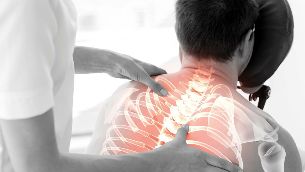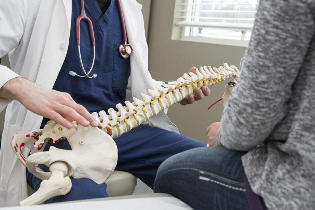Osteochondrosis is a set of destructive changes of the spine accompanied by damage and rapid destruction of the intervertebral discs. The latter consist of cartilaginous tissue, and therefore susceptible of degeneration under the influence of a wrong load on the spine. Osteochondrosis of the lumbar fixed patients of any age. But at risk included people over the age of 30, and patients engaged in regular physical labor, sports.

One of the most pronounced symptoms is a strong pain, accompanied by a limitation in the lumbosacral region. Low back pain often becomes a complication of another disease of the skeleton and entails serious consequences for the spine.
THE STAGE OF DISEASE PROGRESSION
There are four stages of progression of degenerative disc disease of the lumbar spine:
- Characterized by intermittent pain manifested during locomotion. The pain is localized in the lower back and buttocks can be felt tingling in these areas of the body.
- In the second stage can be diagnosed first marked destructive changes, including the destruction of the annulus, a compression of nerves. Pain syndrome is manifested during exercise, becomes sharp and progressive. Patients feel relieved when bending the body backwards.
- The progression of destruction of the fibrous ring leads to the destruction of cartilage and the formation of intervertebral hernia. The pain becomes constant and increases with physical activity.
- The cartilage continues to deteriorate, the affected areas of the spine are formed pathological growths, reducing the functionality of the skeleton. Decreased mobility and flexibility, pain is constant with different intensity.
As a rule, therapy amenable only to the first degree of development of osteochondrosis of the lumbar spine. Treatment in other situations is a set of measures that slow down destructive processes and improves the health of patients.
SYMPTOMS AND SIGNS OF DAMAGE
Pain in the lumbar region, experienced when bending and other movements are the first signs of a destructive disorders. Pain indicates the destruction of the disc and compression of nerve endings. Other symptoms:
- the decrease in the intensity of pain in the presence of the torso in a horizontal position;
- weakness in the lower extremities;
- leg numbness, loss of tendon reflexes;
- curvature of the spine in the lumbar region left, right, lordosis and kyphosis.
In the later stages it is also possible incontinence of stool and urine. Pain occurs even with slight exertion (e.g. coughing and sneezing). Partial and full paralysis observed for inoperable degenerative changes.
Accompanying symptoms:
- numbness and tingling in the lumbar region;
- the discoloration of the skin in the buttocks, hips, waist, darkening of the skin;
- the feeling of tension in flexion and extension of the trunk;muscle wasting and reduced activity (often occur as a complication of the disease);
- dryness and peeling of the skin;
- violation of sweating;
- autonomic disorders caused by changes of blood circulation, lack of nutrition of the tissues with oxygen;
- the lack (reduction) libido and sexual dysfunction.
Violations of sensitivity is observed, as a rule, directly in the lesion. With possible hypersensitivity (increased), anesthesia (decreased sensitivity) and paresthesia (feeling of tingling).
Most often disease are exposed to men because they are more engaged in physical work. The progression of the disease is faster and the likelihood of sexual dysfunction is several times higher than in women.
THE MAIN CAUSES AND RISK FACTORS
Osteochondrosis of the sacral otdelaeshsya low back pain, the symptoms and treatment which directly depend on the stage of progression, is often complicated the main reasons. Not all preconditions and risk factors resolved in the therapeutic period. Accurately identify and determine the set of reasons is also not always possible.
In the list of main causes of lumbar degenerative disc disease, treatment of which may depend on their definition, included:
- Uneven load on the spinal column, skeleton. Is caused by the upright posture and lack of physiological awareness of the person. Uneven pressure is typical for non-professional athletes and people engaged in heavy physical labor.
- An increased load. Even with the right approach to the skeleton, muscles and spine possible destructive changes. With increased motor activity of the vertebrae wear out faster and are modified, erased cartilaginous discs and pinch nerve endings. In such situations, the first stages are observed protrusions and hernias, which are then complicated by lumbosacral osteochondrosis, treatment of which is limited to symptomatic relief of symptoms and slow further degradation.
- Incorrect posture. Usually this phenomenon is accompanied by an incorrect load distribution on the spine, which leads to further destruction of bone and cartilage. At risk elderly, which show a rapid decline in the elasticity of the intervertebral discs.
- A sedentary lifestyle. Often accompanied with poor posture and uneven distribution of loads. In addition, the changes may cause muscle hypotonia caused by lack of muscle activity. In a constant seated position the spine (especially lower back) is loaded more than usual.
- Significant excess weight. Every extra kilogram of weight creates extra pressure on the spine, which might lead to destructive changes of bone and cartilage. If obesity accompanied by a sedentary lifestyle, the risk of the need for treatment of the lumbar-sacral spine increases several times.
The main reasons can be complemented by risk factors that increase the likelihood of disease and (or) accelerate its development. Among the main factors are:
- flat feet (due to lack of functionality of feet and the uneven distribution of pressure on the spine);
- lesions of the digestive and cardiovascular systems, inflammatory process of bone and cartilage, arthritis, osteoarthritis, osteomyelitis;
- hormonal disturbance diseases of the endocrine system;fatigue, violation of healthy biorhythm;
- frequent stress and violations of psycho-emotional state.
- Doctors recommend to pay special attention to lifestyle. Lack of sleep and stress, poor unbalanced nutrition is more likely to be risk factors for negative catalysts and processes for the spine.
METHODS OF DIAGNOSIS AND IDENTIFY THE CAUSES
For diagnosis are:
- history;
- research status of soft and hard tissues;
- laboratory studies.
At the first visit, the doctor performs a detailed examination, determines the possible external manifestation of the disease, the presence of curvature and changes in skin sensitivity. In addition, the initial examination is required to determine the localization of the pain syndrome. Further held:
- The x-rays. Runs in the side and rear projection. To determine the presence and magnitude of destruction of bone tissue, to identify the size of the growths (if any).
- Magnetic resonance imaging. Allows to determine the localization of damage using multi-angle imaging. Reveals soft tissue destruction, inflammation, nerve damage, blood vessels.
- CT. As the x-ray provides visualization of the hard tissues of the spine and back. Allow for closer examination of existing destructive changes.
METHODS OF THERAPEUTIC EFFECTS
Osteochondrosis of the lumbar treatment is chosen individually. In the early stages of a possible conservative therapy with maintenance of normal health of the patient. In case of serious destructive changes used surgery.
CONSERVATIVE METHODS
Attacks of degenerative disc disease is often accompanied by severe pain requiring relief. With these purposes using drugs:
- Analgesics. Most common: Analgin, Deksalgin, Spazmalgon. Applied in tablet form and also injection.
- Chondroprotectors. Are not medicines, but can maintain the elasticity of cartilage, help restore damage. To a group of medicines include: Artifleks, symptoms, Glucosamine.
- Nonsteroidal anti-inflammatory drugs. The group includes: Diclofenac, Nimesulide, Ibuprofen. Help relieve inflammation and ease pain.
- Myotropic spasmolytics (Mydocalm). Are used to relieve muscle tension and easing pain.
Additionally, apply anti-inflammatory creams and ointments (the Nimid, Traumeel, Dolobene, Finalgon). Stretching the spine additionally used manipulation, massage and physical therapy. The house also allowed the use of physical therapy.

When lumbar osteochondrosis the symptoms and treatment medicines is required only if you experience severe pain and stiff. Medicines are needed to relieve inflammation and causes disease.
SURGERY
When lumbar osteochondrosis the symptoms and treatment at home can be combined only in the early stages at low pain intensity and low negative symptoms of the disease. Surgery is required when serious growths of bone tissue to partially restore the mobility of the skeleton. Also with surgery of herniated discs are removed, destroyed cartilage discs replaced.
FOLK REMEDIES
Folk remedies osteochondrosis of the lumbar, the symptoms and treatment of which are closely interrelated, are used to relieve inflammation and pain. The most effective and safe:
- Pine bath. Bath must be placed in the water a comfortable temperature three or four branches of pine needles. The procedure is recommended before bedtime in a quarter of an hour.
- Tincture of horseradish. In equal proportions mix a tablespoon of vodka and the juice of fresh horseradish. RUB painful areas two to three times a day. After each procedure, close the back with a blanket to warm up.
- Burdock leaf. Pure leaf of a plant hold it over hot steam for ten minutes, then apply it to the affected area on the back. Envelop the waist with a handkerchief or blanket, leave on for one hour.
In the treatment of degenerative disc disease of the lumbar spine the symptoms and treatment it is important to relate. It is not recommended to use the recipes of traditional medicine as an alternative main course. Allowed use of funds as an auxiliary.
PREVENTION AND RECOMMENDATIONS
Prevention of osteochondrosis of lumbar oldelpaso-sacral degenerative disc disease, the symptoms and treatment of which is described above, preventable. To prevent the occurrence of illness should follow the recommendations:
- evenly distribute pressure on the skeleton and the spine, to avoid excessive physical labor;
- balance time for sleep and rest from physical exertion;
- follow the technique of performing exercises during sports;
- to use the rules menu based on the recommendations of a healthy diet;
- to prevent excess weight;
- to take preventive checkups with the surgeon and the neurologist, especially after 30 years;
- to monitor hormone levels and to monitor the condition of the endocrine system;
- to monitor posture and, if necessary, perform therapeutic exercise, use massage and manual therapy.
SUMMARY AND CONCLUSIONS
Progressive in the lumbar region low back pain is the result of an incorrect load distribution on the spine, disregard of rules of establishment of the posture and technique of performing exercises in sports. With age the risk of illness if these factors increases by reducing the regenerative processes of bone and cartilage tissues. Treatment of osteoarthritis is difficult because the spine is not subjected to full recovery. It is therefore important to carry out prevention and to follow the recommendations of a physician.

















































